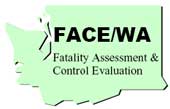Flagger Fatally Injured When Struck by a Car at a Highway Work Zone in Washington State
Washington Case Report 00WA011
Release Date: January 31, 2006
Summary
On February 22, 2000, a 42-year-old male maintenance technician, who was performing the duties of a traffic control flagger, died when he was struck by a car at a highway work zone. The flagger (the fatal victim), was working with a state maintenance team to install a new roadside information sign along a major two-lane state highway. The driver of a small passenger vehicle may have been distracted, or was confused as she entered the work zone. The driver was not able to comprehend the flagger’s instructions and drove her vehicle straight at the victim. The vehicle struck the victim traveling at a reported speed of between 50 – 60 MPH. On impact, the victim struck the hood and windshield of the car, and then was thrown over the top of the vehicle before hitting the asphalt pavement along the highway. A witness who saw the incident immediately called 911 for emergency assistance. Emergency personnel treated the victim on site. He died from his injuries during transport to a local medical facility.
To prevent future similar occurrences, the Washington State Fatality Assessment & Control Evaluation (FACE) investigative team concluded that similar operations working along highway and road construction work zones, should follow these guidelines:
- Use an alternative project plan and design options to perform road and highway work so flaggers are not used for traffic control
- Employers should identify appropriate escape routes for flaggers and other workers in the event that a vehicle does not follow intended traffic controls
- Employers should use positive protective barriers to shield workers from intruding vehicles
- Employers should regularly train and supervise all workers regarding specific hazards associated with work zones
- Consider the use of law enforcement vehicles and personnel to help alert vehicle traffic to highway work zones
Introduction
In February of 2000, the Washington State FACE Program was notified by the WISHA (Washington Industrial Safety & Health Act) Services Division of the death of a flagger (i.e., maintenance technician).
The Washington FACE Principal Investigator and the Field Investigator met with the regional WISHA representative who was investigating the case. After reviewing the case with WISHA, the WA FACE team traveled with the WISHA representative to the incident site. The WISHA representative helped pinpoint the incident location, the site details and helped define the position of the people and equipment involved in this incident. The Washington FACE Field Investigator also met with the safety representatives of the agency whose employees were involved in this incident.
The incident site was located along a Washington state highway. The highway was a two-lane blacktop (asphalt) major rural road with moderate to heavy traffic flow. Traffic runs essentially east and west along the highway. There were no intersecting roads near the work zone that would have impacted the incident. The maintenance work team had set up their work zone on the north side of the highway, which blocked the westbound lane to traffic.
The road maintenance work team was in the process of installing posts along the highway and getting ready to set up and attach a new county park information sign to the posts. The sign was to be positioned so that it would be viewed by west bound traffic. The work team consisted of five people. Three of the work team members were working on the sign installation, while the two flaggers (including the victim) were positioned at locations east and west of the work site along the highway.
The work team parked their vehicles along the north shoulder of the highway. Because of the size of the work vehicles and the need to deploy outriggers for stabilization, the trucks directly obstructed the westbound lane of traffic.
Back to Top
Investigation
On February 22, 2000, a Tuesday (morning), a mixed work crew, consisting of highway maintenance technicians (including the victim) and sign installation workers, began work preparing to install a county park sign along a section of state highway, in western Washington State.
The victim began work at 5:00 AM when he reported to the maintenance facility where he started work each day. As a maintenance technician, the victim had many duties, which included operating class A equipment such as dump trucks, front end loaders, graders, and back hoes. He also performed many other duties such as minor repair and maintenance to roadways and occasionally performed flagging duties as needed.
On that morning the victim drove a sand truck to check road conditions and sand icy spots or trouble areas along a section of a Washington highway. He returned to the maintenance facility sometime before 8:00–8:30 that morning. When the victim got back from the road inspection, he was informed that he would be working as a traffic control person/flagger in conjunction with a sign installation team that morning.
The work crew met at the work zone at approximately 9:30AM on that morning. The crew consisted of three sign installation persons and two flaggers (the fatal victim and a co-worker, who was the lead technician, both from the maintenance facility).
When the two flaggers arrived at the work zone, they quickly put on their protective equipment which consisted of white rain suits, retro-reflective orange vests, reflective gloves, and hard hats. The lead technician/flagger and the victim assessed the area and then proceeded to set up the highway warning signs, prior to the county park sign installation work crew positioning their vehicles along the highway work site.
The work team (except for the flaggers) were located either directly behind a guardrail working on an earthen berm where the sign was being installed, or were operating one of the work vehicles being used for the sign installation. All of the maintenance vehicles had their rotating amber warning lights and their 4-way flashing vehicle lights on, to help alert motorists of the highway work zone. The maintenance vehicles consisted of an “Auger Boom Truck” used to dig the post holes and a “Manlift” or “Bucket Truck” used by the work team personnel to mount the sign.
The employer involved in this case had been in existence for over 45 years and had approximately 4000 employees working for them throughout the state. The employer had a very good safety program in place, based on a review by the FACE Field Investigator. The employer had a full time central office safety and health administrator and several regional safety persons.
The company also had several very active health and safety committees, which included a work zone safety committee that meets either on a monthly basis or periodically as needed, such as quarterly during the year. They also conducted “tool box” meetings regularly with work team members on a routine basis to discuss safety and health issues.
The employer trained and certified their own flaggers to conduct organization of roadway projects that needed the use of flaggers for traffic control. The employer had a comprehensive, written accident prevention program and they also had a traffic control plan for the incident work zone site.
The victim, at the time of the incident, was working as part of a five-person crew on the sign installation project. The victim had worked for the employer for a little over 8 years and had almost an equal amount of flagging experience. His primary job was working as a maintenance technician which entailed a variety of duties such as roadway maintenance and occasional flagging duties.
On the afternoon of February 22, 2000, the victim was struck and killed by a motor vehicle traveling through a highway work zone. The driver was a 73-year-old female, reportedly driving a “new-used” car that she was not completely familiar with. She was reportedly having trouble trying to deal with the cruise control feature of her car as she approached the work zone. The driver was charged with vehicular homicide.
The flaggers began by placing the work zone warning signs along the eastbound lane of the highway. They utilized the Manual on Uniform Traffic Control Devices (MUTCD) guidelines as well as the Washington State Department of Transportation guidelines to determine sign placement.* They started by placing a “flagger ahead” pictorial sign about 500 – 510 feet from the eastbound flagging station. The second sign, “Lane Closed Ahead” was place again about 500–510 feet from the first sign. The third sign, another pictorial sign informing motorists of work/construction taking place ahead was set about 500-510 from the second sign.
The flaggers/technicians used their vehicle odometer to establish the distance between the signs. They then set up the westbound traffic warning signs in a similar fashion. The warnings signs on the eastbound lane were given a little extra spacing because the highway along that section of road was a long sweeping curve coming onto the flagging station and the work zone.
The flagging team established their flagging stations approximately 100 feet in advance of the work zone on both the eastbound and westbound lanes. As soon as the flagging team was in position, they informed the sign installation crew that they could move their trucks and equipment into position and begin setting up the work zone (figure 1 shows a schematic diagram of the work zone).
The sign crew lined up their “Auger “ truck and “Manlift” truck on the shoulder of the westbound lane next to a guardrail adjacent to the highway. Both trucks had their 4-way flashing lights and their amber rotating lights on to help warn traffic of the work zone. The trucks also had their outriggers extended to stabilize the vehicles while operating the “boom” on the trucks.
The auger and manlift trucks, because of their over all size, occupied all of the roadway shoulder at that location, and in addition their outriggers encroached approximately between 7-9 feet into the westbound lane of traffic. Because of this encroachment, the work zone was restricted to a single lane of traffic along the work area, controlled by the two flaggers.
The flaggers, as mentioned earlier, were positioned approximately 100 feet in advance of the work zone area, along the westbound and eastbound lanes of the highway. The victim was the traffic controller (flagger) for the eastbound traffic. Both flaggers were equipped with two-way radios for communication. The flaggers were about 250 feet from each other on opposite ends of the work zone.
There was a long sweeping curve traveling east along the highway that preceded the victims flagging station. Although the curve was relatively gradual in nature, traveling at 55-60 miles per hour would bring a vehicle up to the flagging station fairly quickly before seeing the flagger. Traffic on the road that afternoon was moderate to heavy and consisted of a mix of private vehicles, commercial vehicles and large trucks/semi-tractor trailers all traveling at a fairly steady pace along this two lane highway. The speed limit for road was posted at 55 MPH.
The weather for that afternoon was wet and overcast with gray skies. It had been raining in the area that morning but conditions in the early afternoon were a mix of light misty rain or no rain (dry conditions). The pavement conditions were also mixed with wet and dry areas. The sign installation workers were located either directly behind the work vehicles and a guardrail located adjacent to the work site or were on one of the boom vehicles being used for the sign installation.
At approximately 11:50 AM that morning, the lead flagger and the victim talked on the radio discussing how aggressive the traffic had become entering and leaving the work zone. The lead flagger told the victim that at one point he thought he was going to need to jump over the guardrail to avoid being hit by a vehicle heading westbound into the work zone. However, the vehicle stopped before there was a need for the flagger to take evasive action.
Shortly after the radio conversation between the two flaggers, the lead flagger released westbound traffic to travel into the eastbound lane and move slowly past the work zone. It was noted that the time was approximately 11:57 AM. At about the same time, the sign installation crew had finished installing the sign posts and were about to set the county park sign in place on the posts.
At Approximately 11:59 AM the lead flagger remembers looking at the victim and noticed that he was standing about a foot in front of the fog line in the eastbound lane. He was observed facing the center line with his head bent either trying to talk on the radio microphone or trying to take a puff from or removing a cigarette from his mouth. It was noted that his traffic control paddle had the “Stop” side facing eastbound traffic.
At that moment, an eastbound vehicle, a 1996 Chevrolet Cavalier was approaching the flagger station. It appears the victim did not see the approaching vehicle. The vehicle was traveling at an estimated 50–55 mph when it entered the work zone and it was observed that the vehicle showed no sign that it was slowing down. The lead flagger witnessed the vehicle strike the victim. He indicated that he did not hear the car breaking nor did he hear any skidding sounds from the vehicle before impact. He observed the victim hit the windshield and then go flying into the air for about 15 to 20 feet. He landed on his side and slid another 10 to 15 feet along the asphalt pavement before coming to a stop.
The lead flagger and other members of the sign installation crew quickly rushed toward the victim and the driver involved in the incident. They started providing first-aid for the victim while someone called on a cell phone for help. A passing motorist identified himself as first responder/EMT and stopped to assist in first-aid treatment for the victim. The time was about 12:05 PM.
Local police and county sheriff’s department personnel arrived at the scene around 12:14–12:15 PM. County fire and rescue personnel arrived around 12:30 PM. Paramedics from the County fire and rescue quickly took over treatment of the victim. The victim had serious head and chest injuries. At about 1:00 PM, the victim was transported to a local hospital. He died on route at approximately 1:07 PM.
* The MUTCD gives guidance to contractors, municipalities, Departments of Transportation and others on the safe setup and operation of highway and road construction work zones. The Washington State Department of Transportation has its own similar guidelines.
Cause of Death
The medical examiner listed the cause of death as basilar skull fracture due to, or as a consequence of blunt impact to the head.
Recommendations/Discussion
Recommendation #1: Use an alternative project plan and design options to perform road and highway work so flaggers are not used for traffic control
Discussion: The highway or roadway project plan and the selection of design solutions for various traffic management schemes should take into account a multitude of safety and health issues that could be encountered during the project’s implementation. A risk assessment should be part of the project’s design process. If health and safety risk exposures are identified involving workers or motorists traveling through the work zone, then the project plan should include steps to eliminate or reduce those hazards.
All work zones should be set up to comply with the latest state standards and MUCTD guidelines, but it should be noted that these are minimum standards on how to set up a work zone, and do not define elements of the traffic control plan nor aspects of the project plan and design. These are left up to the employer or contractor who is performing the highway work.
Flagging can be a traffic control option for some work zone situations, but should only be employed as a final option when all other methods of traffic control have been reviewed and found to be inadequate or ineffective in managing traffic through, or around a work zone.
After this incident occurred, the organization decided to stop any further work on the county park sign installation until they had a chance to review all of the incident investigation facts and recommendations. After studying the incident and all the investigation reports and carefully assessing the work area, the company made the decision to bring in fill, rock and gravel so that they could safely park their work vehicles completely off the highway and behind the guardrails at that location (photos 5 and 6 show the site before and after filling the slope).
The organization, in essence, decided to follow some of the primary principles of the hierarchy of safety which were to eliminate/substitute and /or engineer out the hazard. They engineered out the hazard by redesigning the work zone and thus eliminating or reducing the hazard of the motoring public for the workers in the work zone. Rock and gravel fill was brought in to build up the berm along the inside of the guardrail so that work could be completed and any future maintenance would allow vehicles and workers to be protected by the guardrail and there would be no need to restrict traffic or establish any traffic control for the area. It was possible to complete the berm work off the roadway and behind the guardrail.
This was a very innovative and effective approach in addressing the hazards associated with this type of work located beyond the shoulder of the road. Even though this method of hazard control can be more time consuming, require more planning, and be more expensive, it is considerably less costly than losing a life for the purpose of installing a highway information sign.
Recommendation #2: Employers should identify appropriate escape routes for flaggers and other workers in the event that a vehicle does not follow intended traffic controls.
Discussion: A key element in work zone planning and preparation, is to determine if the work zone can be set up without using flaggers for traffic control. If there are no other options, and it is determined that flaggers are needed for work zone traffic management, then it is paramount that an effective safety plan be in place that incorporates various elements designed for the safety of the driving public, the workers in the work zone and the flaggers conducting traffic control for the work zone.
Flaggers, because of the nature of their job and their role within the work zone project, are placed in very exposed positions while providing traffic control for a work site. Because of the exposure and the risks and hazards to the flagger from moving traffic, establishing a flagger escape route is not only important but should always be an essential part of any project requiring flagger traffic control.
There are several items that should be considered when planning and establishing a flagger escape route. They include:
- an unobstructed path of travel that the flagger can use to get out of the way of errant vehicles;
- the escape path should consider vehicles traveling from several directions past the flagger station depending on the layout of the work zone;
- the escape path needs to take in consideration the construction work activity taking place, and not direct the flaggers escape route into the construction hazards of the work zone;
Determination of an escape route may take only a few minutes during the overall work zone planning process, but it can mean the difference between life and death for a flagger.
Recommendation #3: Employers should use positive protective barriers to shield workers from intruding vehicles.
Discussion: Fatalities from work zone incidents have increased by more than 50 percent in the last 5 years according to the Federal Highway Administration (BNA Nov. 9 2004). In addition to having a well defined escape route for flaggers, employers should also consider the use of positive protective barriers that flaggers can get behind to protect themselves from intruding vehicles.
The flagger is the key person in facilitating a safe work zone project but the flagger is also very exposed to the hazards of the work zone such as working around trucks and motor vehicles’ traveling at speeds near 55 miles per hour as was the case in this incident report.
A principle purpose of work zone traffic control is to help provide oversight for a safe work area for workers who are in or adjacent to a roadway, while at the same time facilitating a safe and orderly flow of traffic through the work zone. Flaggers, when they are at the work zone flagging station, are often standing within a few feet of moving vehicles, and often have very minimal protection afforded to them outside of their training and visible protective gear.
A strategically placed barrier can provide positive protection for the flagger in the event an errant vehicle poses an immediate danger to the flagger. The barrier(s) should be located and be designed to work in conjunction with the flagger escape plan and escape route. A barrier that could be used might be something as basic as the construction vehicle that was driven to the work site like the pick-up truck used by the victim, or a concrete barrier or similar positive protective barrier that could be transported to the work location.
In California, a senior materials and research engineer from the California Department of Transportation (CalTrans) developed a portable protection device consisting of a trailer loaded with sand barrels that could easily be placed in front of workers to help protect them from errant vehicles that travel out of the designated travel lanes and into the work zone.
Existing protective devices such as roadway guardrails and natural topography features of the work zone could also be used as protective resources for the flagger in an emergency situation. One of the Washington State Department of Transportation guidelines for flagger safety, states that flagger stations with no escape route, are not allowed unless positive protection is in place at the flagger station.
Recommendation #4: Employers should regularly train and supervise all workers regarding specific hazards associated with work zones.
Discussion: All flaggers need to be trained and supervised on how to most effectively work near motor vehicle traffic in such a way as to minimize hazards related to the flagger’s specific traffic control responsibilities.
The victim’s flagger station in this incident, was located adjacent to the eastbound section of a road just in advance of the work zone, and was situated along a long sweeping curved section of a major two-lane highway.
The highway had a paved shoulder that then gave way to a section of sloped packed soil and weeds. Witness statements and police reports indicate that the victim was perhaps standing in the eastbound traffic lane side of the highway fog line and was not facing oncoming (eastbound) traffic at the time of the incident.
Flaggers should always stand in a highly visible area along the shoulder or on a sidewalk but out of the vehicle traffic lanes. The flagger should face oncoming traffic and be positioned so they are out of both the public traffic lane and the active work zone.
Training for flaggers and other highway and road construction workers should extend beyond their initial training and certification processes. Providing job safety instruction, training, and education for workers needs to be a continuing process.
A daily briefing should be conducted prior to each day’s work activity. The briefing should include a discussion of various elements of the job/site safety plan and a more detailed discussion of the activities for that day. Before starting a flagging job the employer and flagger need to familiarize themselves with the work area, and evaluate known and potential hazards. They then should review safe practices with flaggers and how they should address the identified hazards.
Safety procedures should be developed for the work site and be enforced. The employer should make routine inspections of the work site and make corrections and changes to the work zone process and their internal safety and training plans as necessary.
Recommendation #5: Consider the use of law enforcement vehicles and personnel to help alert vehicle traffic to highway work zones.
Discussion: The placement of law enforcement vehicles before a work zone has been used effectively to alert motorists. Vehicles may be placed off the roadway with lights flashing to warn the public of both the parked vehicle and the work zone. It is preferable for officers to remain inside the vehicle to minimize their risk from passing traffic.
Alternatively, flashing signs and lighted message boards might be considered to be used in conjunction with standard tent-type diamond warning signs. Providing additional visual cues may be necessary for some drivers who could be fatigued, distracted or otherwise impaired while approaching the work zone.
Standard work zone signage, while appropriate, may not provide the level of signal necessary to attract the attention of some drivers. More drivers may slow down at the sight of flashing lights from a law enforcement vehicle than from standard static signs at the edge of their view.
Back to Top
Bibliography
- Bureau of National Affairs (BNA), (2004), “Motor Vehicle Safety: Study Looks at Barrier System Use for Separating Road Workers, Motorists,” Occupational Safety & Health Daily, November 9, 2004.
- Safety Standards for General Safety and Health, Chapter 296-24 WAC, State of Washington, Department of Labor and Industries.
- Safety Standards for Safety Standards for Construction Work, Chapter 296-155 WAC, State of Washington, Department of Labor and Industries.
- Employee Protection in Public Work Areas, Chapter 296- 45-52530 WAC, State of Washington, Department of Labor and Industries.
- Manual on Uniform Traffic Control Devices (MUTCD) Millennium Edition, Standards and Guides for Traffic Controls for Street and Highway Construction. 2000 Edition of MUTCD, December 2000, U.S. Department of Transportation, Federal Highway Administration, Fredericksburg, VA: American Traffic Safety Service Administration.
- Work Zone Traffic Control Guidelines. M54-44, Washington State Department of Transportation, Field Operations Support Center, May 2000.
- Trout, Nada D., Ullman, Gerald L., Devices and Technology to Improve Flagger/Worker Safety/Research Report 2963-1F. College Station Texas: The Texas Transportation Institute, The Texas A&M University, Texas Department of Transportation. 1997.
- Graham, Jerry L., Hinch, John, Stout, Dale, Lerner, Neil, Maintenance Work Zone Safety. Washington, DC: National Research Council, Strategic Highway Research Program, 1990.
- Highway Work Zone Safety. Washington State Department of Transportation, January 1994.
- U.S. Department of Transportation, Federal Highway Administration. “Shields of Steel: California Introduces New Mobile Work Zone Protection Device.” Research & Technology Transporter, January – February, 2004.
Acknowledgements
The Washington FACE Program would like to thank the company involved in this incident for aiding in the investigation as well as external reviewers that included the Washington State Attorney General’s Office, Washington Industrial Safety and Health Act (WISHA) Services, Washington Department of Transportation, the National Institute for Occupational Safety and Health (NIOSH), and SHARP Program staff.
Figure and Photographs
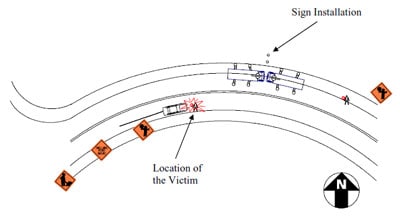
|
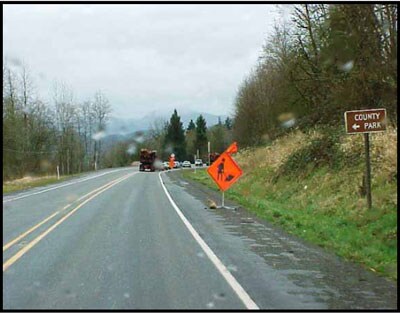
|
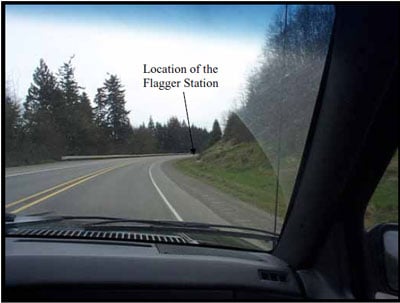
|
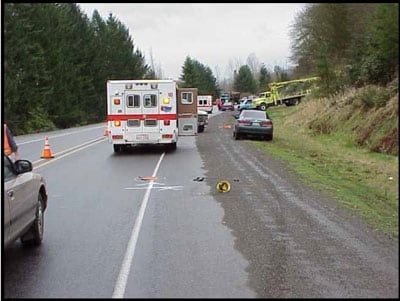
|
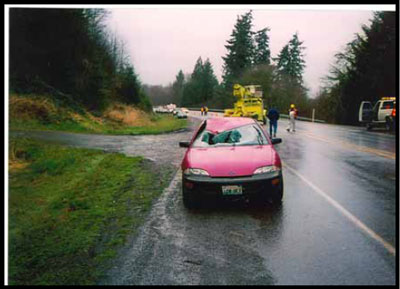
|
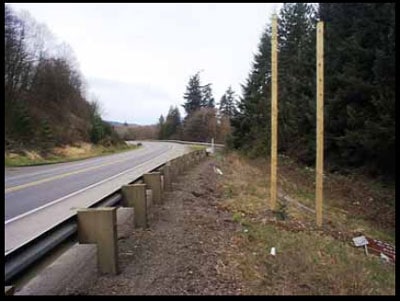
|
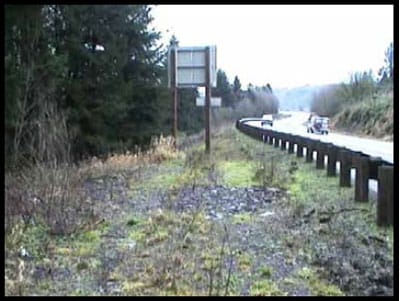
|
|
Photo 6. AFTER – Shows the work zone site during 2nd post-incident FACE investigation site visit, and after fill, rock & gravel had been brought in so sign installation could be completed off the roadway without impacting highway traffic. This view is looking east along the westbound lane of highway.
|
Back to Top
Washington FACE Program/SHARP
To contact Washington State FACE program personnel regarding State-based FACE reports, please use information listed on the Contact Sheet on the NIOSH FACE web site Please contact In-house FACE program personnel regarding In-house FACE reports and to gain assistance when State-FACE program personnel cannot be reached.

